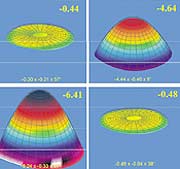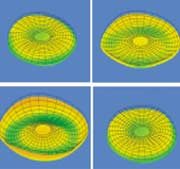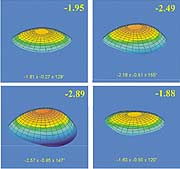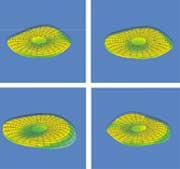Dynamic aberrometry may help surgeons measure accommodation
Specialists say evaluations for IOL surgery may be enhanced with the technology.
Dynamic aberrometry is a new technology that may be helpful for measuring the outcomes of accommodative IOLs and other surgical techniques aimed at overcoming presbyopia.
Surgery to alter the accommodative state of the eye in patients with either presbyopia or cataracts is gaining increasing attention. Several types of accommodative IOL are in development. Scleral expansion, aimed at increasing the diameter of the circumferential ciliary muscle complex, is also performed by some surgeons. Current techniques include creation of radial scleral incisions to allow expansion of the eye’s anterior scleral ring under IOP, as well as implantation of devices to cause forced expansion of the ciliary complex.
|
|
|
However, one element impeding this area of development is the inability to accurately and objectively measure the change in accommodation achieved by the surgery.
“One of the challenges in this field is to develop the ability to measure the effects of the surgery objectively,” said Dan Z. Reinstein, MD, MA, FRCSC, assistant professor of clinical ophthalmology and director of refractive surgery research at the Weill Medical College of Cornell University, New York and in private practice in London.
Dynamic aberrometry
“Accommodation is a dynamic process. It is a continuous variable. The eye may accommodate a little or a lot. It may be able to sustain accommodation or fluctuate,” Dr. Reinstein said.
Dr. Reinstein has been working with the WASCA Analyzer (Carl Zeiss Meditec AG), a Shack-Hartmann wavefront analyzer that is capable of obtaining instantaneous aberrometry data in real time.
“Measuring accommodative range by near-card acuity testing, or near-fogging techniques, is fraught with subjective patient variables,” he said.
“By acquiring data in a free-running mode, instantaneous changes in the wavefront can be followed, recorded and played back as a movie. This allows clinicians to examine wavefront changes dynamically. Particularly for custom ablation planning, we can choose the wavefront most likely to correspond to a state of no accommodation. This can be confirmed by taking the exam with the lowest sphere value recorded within the time-window of acquisition. This is important, in order to not produce overcorrections in customized corneal ablation.”
The WASCA Analyzer is capable of acquiring 210 wavefront measurements over a 30-second acquisition window.
“The temporal resolution, at 7 Hz, is so high, it allows us to monitor even wavefront changes caused by redistribution of the tear film over the cornea,” Dr. Reinstein said.
Normal eye accommodations show changes in higher-order aberrations. in particular spherical aberration, changes during the accommodative process,” he said.
Hysteresis of aberrations
Hartmut Vogelsang, PhD, of Carl Zeiss Meditec, together with Dr. Reinstein and colleagues, recently confirmed with dynamic aberrometry that in the normal eye, along with an increase in ocular spherical power during accommodation, there is a concurrent increase in spherical aberration.
“We have been intrigued by a newly discovered dynamic phenomenon: the existence of hysteresis between the change of spherical aberration and the change in sphere during accommodation,” Dr. Vogelsang said. “Because of the high frame-rate of dynamic aberrometry in the WASCA analyzer, we are able to detect that at the start of the accommodative response, spherical aberrations in-crease before the spherical myopic shift (findings in cooperation with Ioannis G. Pallikaris, MD).
“This phenomenon could have evolved to increase the speed with which the eye can perceive near objects. The preliminary increase in spherical aberration would increase the depth of focus of the eye and the near field would be brought into focus in advance of the change in actual sphere (or myopization).”
Accommodating IOLs
H. Burkhard Dick, MD, assistant clinical professor and director of refractive surgery at Johannes Gutenberg-University in Mainz, Germany, had used dynamic aberrometry to examine the voluntary range of pseudoaccommodation in elderly patients. These patients underwent cataract extraction and implantation of the 1CU accommodative IOL (HumanOptics), which is currently in clinical trials. After successful phacoemulsification and implantation of the 1CU lens, patients were tested by video-aberrometry.
“The patients were asked to observe a target set at 4 meters. On cue, they looked at a target at 23 cm for 10 seconds, followed by a return look at the 4-meter target,” Dr. Dick said.
The WASCA Analyzer was able to objectively demonstrate an amplitude of accommodation, as well as the way the accommodative effort changed over the 30-second period.
“Interestingly, in most cases, a fairly stable accommodative state was achieved by the eye. However, we are interested in looking at this phenomenon in more detail, over longer periods of accommodation and over longer follow-up times,” he said. “What will be interesting to note with the 1CU patients is that they do not appear to experience the increase in spherical aberration during accommodation seen in normal non-presbyopic phakic eyes.”
“If increased spherical aberration is truly an advantage, perhaps this is one element of IOL technology that could be incorporated into future designs — an optic that would change its aberrational structure and hence increase the depth of focus of the eye in the accommodative state,” Dr. Reinstein said.
But dynamic aberrometry may have other applications in refractive surgery, according to Dr. Reinstein.
“Such dynamic measurements may help us to really begin to understand what our final goals should actually be in providing customized LASIK and PRK ablation. It is becoming increasingly evident that the best of us with 20/12 uncorrected vision still have measurable aberrations at distance, and flattening these out completely could adversely affect visual function,” he said.
For Your Information:
- Dan Z. Reinstein, MD, MA, FRCSC, can be reached at Reinstein Institute/Eye Academy of London, 42 Molyneux St., London W1H 5JA, UK; +(44) 20-7724-5061; fax: +(44) 20-7681-1233; e-mail: dzr@reinsteininstitute.com; Web site: www.ReinsteinInstitute.com. Dr. Reinstein is a paid consultant for Carl Zeiss Meditec AG.
- Hartmut Vogelsang, PhD, can be reached at Carl Zeiss Meditec AG, Goeschwitzer Strasse 51-52, 07745 Jena, Germany, +(49) 3641-220-100; fax: +(49) 3641-220-102.
- H. Burkhard Dick, MD, can be reached at Department of Ophthalmology, University of Mainz, Langenbeckstrasse 1, 55131 Mainz, Germany; +(49) 6131-175150; fax: +(49) 6131-175566; e-mail: dickburkhard@aol.com. Dr. Dick has no direct financial interest in the products mentioned in this article, nor is he a paid consultant for any companies mentioned.
- Carl Zeiss Meditec AG, manufacturer of the WASCA Analyzer, can be reached at Goeschwitzer Strasse 51-52, 07745 Jena, Germany; +(49) 3641-220-0; fax: +(49) 3641-220-112.
- HumanOptics, manufacturer of the 1CU accommodative IOL, can be reached at Spardorfer Strasse 150, 90154 Erlangen, Germany; +(49) 9131-506-6586; fax: +(49) 9131-506-6590; e-mail: hahn@humanoptics.com.




